Overview Link to this section
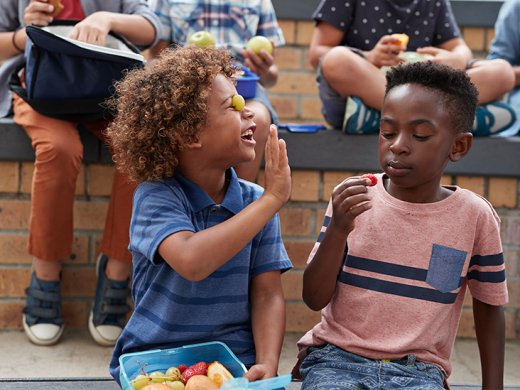
We each develop at our own pace, so it's impossible to tell exactly when a particular student will reach a specific milestone or learn a given skill. The developmental milestones below will give you a general idea of the changes you can expect as each five and six-year-old gets older, but don't be alarmed as each student takes a slightly different course. Honor where they are and support them as they develop.
Five
Link to this section
Physical Development
-

- Reverse letters and numbers, either swapping positions, as writing "ot" for "to," or drawing the letters themselves backward so that a "d" looks like a "b"; to help children become more self-aware, teachers can ask about the letter they reversed but not ask them to correct the reversal
- Find it hard to space letters, numbers, and words; using a finger as a separator helps
- Visual focus is on objects close at hand; still have difficulty copying from the board
- Need lots of physical activity; love indoor and outdoor physical play and activity, including lively games.
- Better control of running, jumping, and other large movements
- Staying focused in structured physical education classes can be difficult
- Often fall or slip out of chairs sideways
- Usually pace themselves well; will generally rest before they're exhausted
- May prefer to work standing up; some schools are now providing some stand-up desk spaces
- Still awkward with writing, handcrafts, and tasks requiring small movements
- Hold pencils with a three-fingered, pincer-like grasp; may need a pencil grip to help them relax
- Ready to begin learning manuscript printing; not always able to stay within lines
Social & Emotional Development
-

- Older fives may challenge adult authority and seem oppositional at times
- Want verbal permission from adults; can pace themselves while doing a given task but may need to be released to move from task to task; before acting, will ask "Can l...?"
- Need consistent routines, rules, and discipline; respond well to clear and simple expectations, such as "I will always ring the chime just once, which means put down what's in your hands and look at me"
- Can sit and work at quiet activities for fifteen to twenty minutes at a time, particularly tasks with manipulatives such as pretend or real money, counting cubes, attribute blocks, and other concrete objects
Communication & Language
-
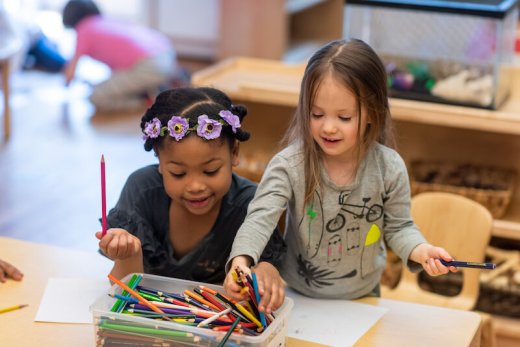
- Younger fives express themselves in few words; "play" and "good" are favorites
- More complex in their imaginative expression than fours; like to express themselves through words, drawing, and drama
- Often read aloud even when asked to read silently
- Older fives like to explain things and have things explained to them; will often give elaborate answers to questions
Cognitive Development
-
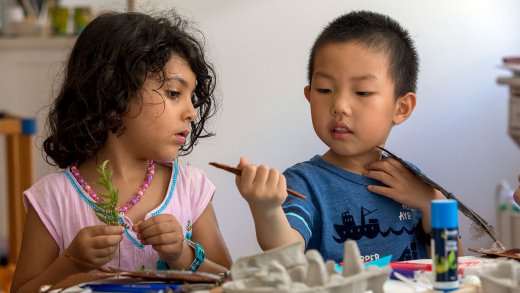
- Often see only one way to do things; rarely see things from another's viewpoint
- Not ready to understand abstract concepts such as "fairness"; the teacher will have to provide lots of examples as the year progresses: "Each one of you gets the help you need to learn new things - this is how I will be fair to everyone in our classroom"
- Imagination can be vivid, which can lead to believing toys and other objects are actually alive
- Learn best and express thoughts through active play, repetition, copying, and hands-on exploration of materials such as manipulatives, clay, sand, and water
- Think intuitively rather than logically; for example, "It's windy when the trees shake, so the trees must make the wind"
- Like to copy and repeat stories, poems, songs, and games, sometimes with minor variations; enjoy sets of similar math and science tasks
- Can become stuck in repetitive behavior (for example, always drawing rainbows or flowers) for fear of making mistakes when trying something new
- May still "talk their thoughts" out loud; for example, saying "I'm going to move the truck!" before doing so (more typical at four)
- Do best learning with predictable daily schedules reviewed each morning and carried out with a minimum of transitions; need clear routines for these transitions; as much as possible make sure the key events in the day, such as snack, art, and closings circle, happen in the same place, and at the same time
Reading, Writing, & Across The Curriculum
Reading - Provide opportunities for children this age to:
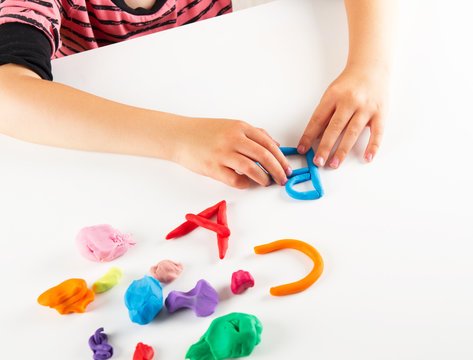
- Vocalize while they read or read out loud quietly to themselves, rather than being expected to do sustained silent reading
- Do "partner" reading - peers helping each other through familiar books; both need to play an active role (as in "parallel" reading)
- Have short chapter books read to them sometimes by readers from older classrooms
- Write stories or reports with a partner or small group of classmates and turn them into books for the classroom library
- Strengthen their reading skills by reading predictable books (books with few words, much repetition, and many pictures)
- Engage in regular systematic and targeted phonics instruction
- Create labels, signs, posters, and charts identifying familiar objects in their environment, such as areas of the room, use of shells, etc.
Writing - Expect from children this age:
- Writing: Labeling of drawings with initial consonants or vowels to stand for one feature in the drawing (as in "H" for "house" in a drawing of houses, people, and trees); tell stories in a single drawing and one or two words
- Beginning Spelling: Largely pre-phonemic or early phonemic -- beginning to use initial consonants or vowels to represent words and sometimes stringing those initial letters together in "sentences" such as I STBFL (I see the butterfly)
- Writing Themes: Family, family trips, fairy tales, tales of good and evil, stories about pets, and stories about themselves and best friends
- Handwriting: Switch to a three-fingered pencil grasp; tendency to write only uppercase letters; as an understanding of spelling develops, use of irregular spacing between words
Across The Curriculum - Provide opportunities for children this age to:
- Take risks and try new things through teacher structured daily challenges, such as drawing a forest without flowers or drawing a rainbow vertically on the page; ask them for ideas as well.
- Take part in active structured playground games in PE, at recess, or in the regular classroom.
- Practice making controlled small movements through simple activities such as weaving, tying shoes, and tracing mazes.
- Learn and practice language skills through teacher modeling, directed role-play, and dramatic play.
- View and draw simple three-dimensional blocks or shapes from different sitting positions to help them see things from different points of view.
Physical Development
-
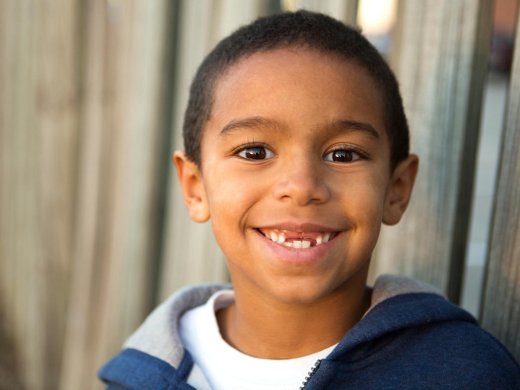
- Noisy, sloppy, and in a hurry; fingers are sometimes clumsy and tasks need slowing down or repeated practice to achieve desired results
- May fall backward out of their chairs at this age rather than sideways as at 5
- Children at this age are teething, so they often chew on pencils, fingernails, hair, books, and other objects
- Work in spurts and will tire easily
- Enjoy being active, both inside and outdoors
- Good visual tracking from left to right and back to the beginning of the next line is normative as sixes begin to read
- Some will still have difficulty copying from board or chart; provide handouts for students to copy from at their desks
- When writing, find spacing and staying on the line difficult because they are more interested in process than product
- Often more comfortable standing up to work, even at their desks
Social & Emotional Development
-
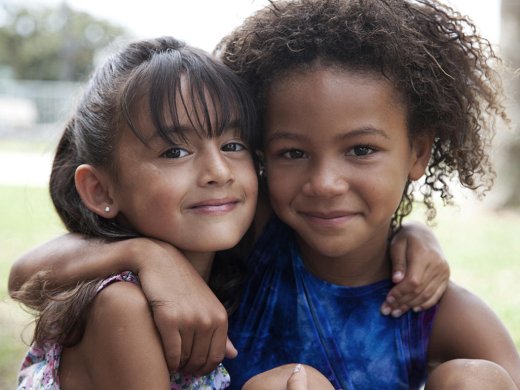
- Proud of their accomplishments and highly competitive
- Sometimes "poor sports" or dishonest; may invent new rules so they can win; cooperative challenge activities take the edge off their fierce need to win individually
- Anxious to do well; extremely sensitive; severe criticism can truly be traumatic
- Tremendous capacity for enjoyment
- Can be bossy, teasing, or critical of others; bossy behavior is sometimes related to competition for friendships
- Tend to complain frequently and use tantrums, teasing, bossing, complaining, and reporting on classmates to try out relationships with authority; need adult understanding but also clear boundaries and limits for acceptable behavior; it can be helpful to read books about teasing, etc.
- Care a great deal about friends; may have a best friend
- Sometimes more influenced by happenings at school than at home
- Enjoy working and playing in groups; engage in more elaborate cooperative and dramatic play than at 5
- Like doing things for themselves; ready to try taking on individual and group responsibility
Communication & Language
-
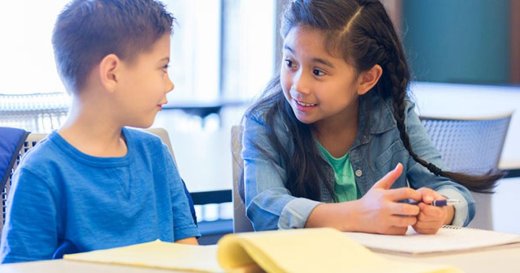
- Use boisterous and enthusiastic language
- Love jokes and guessing games that the whole class can engage in; a fun activity is trying to guess a number by asking questions and explaining how they "got" the number before saying the answer
Cognitive Development
-
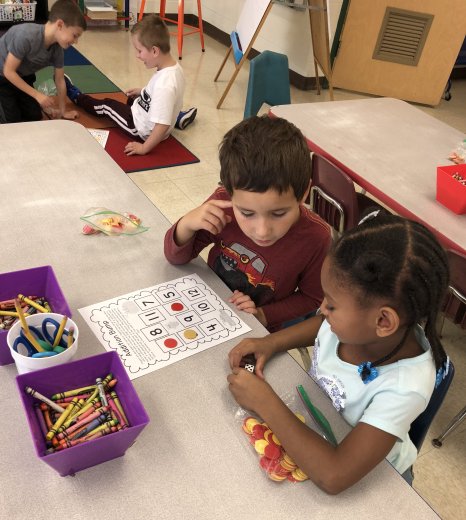
- Better understanding of past and present, long ago and far away; can begin to understand real history markers
- Very motivated to learn; enjoy the process more than the product; beginning to value skill and technique for their own sake
- Love to color, paint, read, and write; experience an artistic explosion; learn the most when teachers value their efforts and encourage risk-taking
- Comfortable with a busy level of noise and activity
- Enjoy and learn from games, poems, riddles, and songs
- Proudly produce a great quantity of work but are unconcerned with quality; can produce products of higher quality when encouraged to work more slowly or when teachers limit the number of complexity of tasks
- Enjoy and learn from field trips followed by opportunities to tell about trips or use blocks to recreate things they saw
Reading, Writing, & Across The Curriculum
Reading - Provide opportunities for children this age to:
-
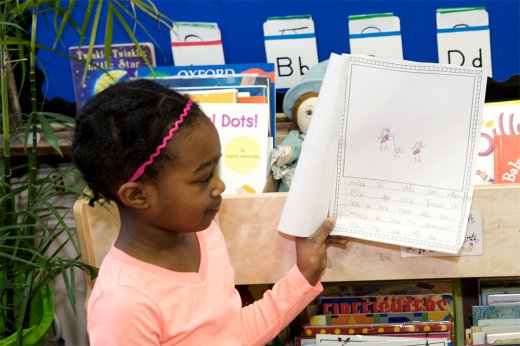
- Continue targeted phonics learning
- Continue reading decodable texts and predictable texts while beginning to move on to easy chapter books
- Use writing, drawing, clay, painting, drama, or blocks to show their thoughts and feelings about a story
- Show their understanding of differences between genres (for example poetry versus a report; fiction versus nonfiction)
Writing - Expect from children this age:
- Writing: Story development still strongly influenced by drawing, for example, stories based on a collection of drawings; writing whole sentences that are early phonemic or use "letter name" spelling strategies -- "I WNT TO HR HS" for "I went to her house"
- Beginning Spelling: Letter naming and "transitional" spelling ("My frends ride bikes"); emerging sense of phonetic clues
- Writing Themes: Best friends, school-related stories, family, pets, going on trips, new possessions, holidays, fantasy
- Handwriting: Proper grasp of pencil; letters the same size or slightly larger than at five and more sloppily written because children are rushing and experimenting with new letter formation; spontaneous mixing of uppercase and lowercase letters; unpredictable spacing
Across the Curriculum - Provide opportunities for children this age to:
- Take short wiggle breaks throughout the day
- Have a range of choices with different degrees of difficulty for working on classroom projects and representing learning
- Enjoy surprises and treats, including learning new games, inventing new characters, drawing treasure maps
- Use new tools such as magnifying glasses or field journals to draw in
- Make and use maps of the classroom, their room at home, or their route from home to school
- Practice newly learned techniques; for example, to help them understand how scientists observe and measure growth over time, they might draw pictures of a seed they plant in the classroom and draw its growth each day
- experiment with clay, paint, dancing, coloring, bookmaking, weaving, singing, and other arts
Credit Link to this section
This content on development comes from Yardsticks: Child & Adolescent Development by Chip Wood and has been lightly adapted to better reflect the language usage and practices of SFUSD.
This page was last updated on August 15, 2022

